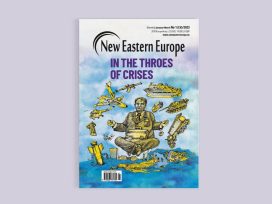
Incomplete Europe
New Eastern Europe 1–2/2023
What the war in Ukraine has taught us about solidarity; why European democrats must insist on fair play; and Moldovan democracy under hybrid attack.
In Romania, the commemoration of ’89 always means remembrance of those who died for freedom. But three decades since the fall of communism, responsibility for the victims has yet to be clearly established. Meanwhile, concerns about the rule of law appear more pressing.
For many Romanians, the fall of the communist regime in 1989 was an unexpected moment that brought hope for a different way of life and a better future. Nicolae Manolescu, a Romanian literary critic, public intellectual and politician in The Right to Normality (published in 1991) pleaded for the restoration of normalcy after the political, social and cultural ‘rupture’ brought by the communist regime in Romania. But what did this ‘normality’ mean, and who was asking for it?
There were numerous politicians, in particular former political prisoners or émigrés, mainly from the historical parties that were revived after the fall of communism, who maintained that the path for post-communist Romania should be found in the interwar period. The few decades between the two World Wars were a time when Romania was a democratic country with functional institutions. It had a flourishing economy and a fruitful cultural scene that was connected to the wider world. The communist regime imposed by the Soviet Union after the Second World War was considered a historical accident and an interruption of the ‘organic’ trajectory of Romanian history.
Apart from politicians, there were other prominent public voices who thought the same: the inspiration for the post-communist period – social reconstruction and general development – should be found in interwar Romania. For instance, Octavian Paler, a Romanian writer and civil activist during the 1990s and early 2000s, referred to the interwar period as the veritable miracle in which Romania synchronised with the West and managed to transform Bucharest into a little Paris; and Romania, a Belgium of the Orient.
For others, the interwar period offered not only inspiration but the key to survive during communism. Andrei Pleșu, a former Romanian foreign minister and president of the New Europe College, a prestigious institute of advanced studies in Bucharest, is a case in point. In an article written around a question asked by Bruce Ackerman – how he managed to intellectually survive during communism – Pleșu explained that the most important intellectuals of his generation were the product of formative stages spent near former political prisoners. These intellectuals were arrested when the communist regime took power in Romania, pardoned only after 1964 and become the transmitters of a tradition of ‘intellectual normality’. As Pleșu explained, ‘educated before the Second World War in a democratic Romania with good schools and good teachers who had studied at great European universities – a Romania which made the appearance of Constantin Brâncuși, Tristan Tzara and later the triad of Mircea Eliade, Eugen Ionesco and Emil Cioran possible – these former political prisoners were for us a guarantee of continuity.’
But this is only one side of the story. The other one was manifested and felt at the level of ordinary people who became the ‘social victims’ of 1989. More and more, because of the protracted post-communist transitions, the communist regime came to be considered by the public as a lesser evil than the system of ‘wild capitalism’ and ‘original democracy’ – two terms used to critically and ironically refer to Romania post-1989. Many could not adapt to the new social reality – to the market economy and to capitalism, where one has to struggle for a living and identify opportunities. People started to long for the paternalist, yet precarious, stability they had become accustomed to during communism.
To paraphrase Svetlana Boym, the communist regime began with futuristic utopia and ended with nostalgia. In post-communist Romania, there were two competing registers of nostalgia felt which informed citizens’ hopes and dreams for the future. On the one hand, there was the idealised interwar period; and on the other hand, communist stability. The latter was now considered by many as not so adverse, if only Nicolae Ceaușescu, the last leader of the Romanian Communist Party, had not ‘perverted’ it. This should be taken into account when referring to the commemoration of 1989.
This year, three decades since the fall of communism, we celebrate a significant milestone. Coming to terms with the past is still an ongoing process in Romania. Many things were done, but there is much more to accomplish. Nonetheless they come to the fore every year – and here, I shall mention a few.
The most central action over the past three decades has been the condemnation of the communist regime. In 2006 Romania became the third former Eastern European communist country (after the Czech Republic and Bulgaria) to officially condemn its communist past. In order to achieve this, the Romanian president, Traian Băsescu, established the ‘Presidential Commission for the Study of the Communist Dictatorship in Romania’, headed by Vladimir Tismaneanu, a Romanian-American political scientist. The commission drafted an extensive report, in which the president condemned the Romanian communists as ‘illegitimate and criminal’. However, the condemnation did not solve the problem of its memorialisation. In December 2006 one of the commission’s proposals was to establish a national museum of communism. The proposal was accepted by the president, but so far nothing has been done due to a lack of consensus, and the tendency to politicise any proposal or attempt to reach a solution.
Nevertheless the 30-year anniversary is not very present in the Romanian public space. This is largely because it overlaps with another significant anniversary. In 2018 Romania celebrated a century since the formation of the modern state. After the First World War, all the provinces in which Romanians were the majority united with the Romanian Kingdom. The centenary was celebrated last year, and the government decided to extend it for two more years.
However, coming to terms with its communist past is not an easy task for Romania and it is an ongoing story. It is not only about getting a consensus on its memorialisation, but also about solving the legal criminal issues related with the 1989 revolution. The Romanian anti-communist revolution that started in Timișoara in 1989 was a chapter with many human losses. According to official records, there were over 1,100 deaths and more than 4,000 injuries during the 1989 revolution. In Romania, the commemoration always means the remembrance of those who died for freedom. But in the three decades since the fall of communism, it has still to be clearly established who should be held responsible for those victims.
Although the Romanian communist party has been condemned as illegitimate and criminal, the problem of responsibility for its victims has still to be resolved. The revolution has been tremendously politicised. It was opened, closed and re-opened again. Certainly, it remains one of the most contentious chapters of the post-communist period. Last year, President Klaus Iohannis approved the criminal prosecution request against Ion Iliescu, Petre Roman and Gelu Voican Voiculescu. By the end of the year, two of them – Iliescu (president of Romania 1992–1996, 2000–2004) and Voican Voiculescu (president of the Romanian Institute for the Study of 1989 Revolution) – were officially charged with crimes against humanity in April 2019. Both are old and the trial will certainly be a long one. If found guilty, the verdict will be largely symbolic.
Nevertheless, today’s challenges appear to be far more pressing for society than the commemorating of the 1989 revolution. These concerns are mostly related to the current state of Romanian democracy and the rule of law. At the end of March this year, 12 embassies in Bucharest issued a joint statement on behalf of 12 countries, (Austria, Belgium, Canada, Denmark, Finland, France, Germany, Ireland, the Netherlands, Norway, Sweden and the United States) asking the Romanian authorities to abstain from any amendments on laws that would further weaken the rule of law in the country. Moreover, there are discussions on the European level about the possibility of invoking Article 7 of the Treaty of the European Union against Romania.
This year’s commemoration should be held against the promises of 1989. Romania has not become the place that has realised the hopes and dreams it had 30 years ago. For instance, the undeniable reality is that over the past ten years, almost four million Romanians have left the country. Many emigrated, mostly to Western Europe, in search of a better life. In 1989 many Romanians dreamed of a better future in their own country, but today more and more are escaping in order to seek a better way of life elsewhere. Compared to the enthusiasm and hope felt in 1989, today’s imagination about a bright future in Romania has, sadly, all but disappeared.
Published 4 June 2019
Original in English
First published by New Eastern Europe 3-4/2019
Contributed by New Eastern Europe © Eugen Stancu / New Eastern Europe / Eurozine
PDF/PRINTSubscribe to know what’s worth thinking about.

What the war in Ukraine has taught us about solidarity; why European democrats must insist on fair play; and Moldovan democracy under hybrid attack.

What is racism against eastern Europeans? And what did Viktor Orbán learn from Slavoj Žižek?